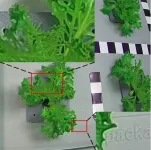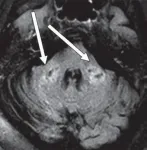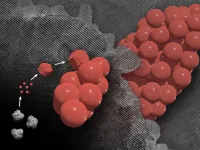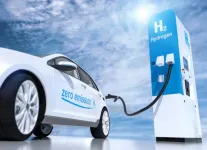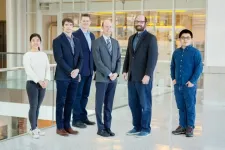Skies of blue: Recycling carbon emissions to useful chemicals and reducing global warming
Researchers optimize a novel process for the efficient conversion of carbon emissions into useful chemicals like acetate using microbes
2021-02-17
(Press-News.org) Rapid global urbanization has dramatically changed the face of our planet, polluting our atmosphere with greenhouse gases and causing global warming. It is the need of the hour to control our activities and find more sustainable alternatives to preserve what remains of our planet for the generations to come.
Carbon dioxide (CO2) and carbon monoxide (CO) make up a large proportion of industrial flue gases. Recent research has shown that certain microorganisms are capable of metabolizing these gases into useful by-products. Thus, attempts are now being directed to using microbes to recycle these gases and convert them into useful chemicals in a process known as 'carbon capture and utilization' (CCU). This is a step beyond the current widespread practice of 'carbon capture and storage' (CCS). However, such CCU requires high energy input making the scaling up of this process difficult and expensive. How can this process then be optimized for maximum output?
A team of researchers from Korea, led by Prof. Jung Rae Kim from Pusan National University, have answered this question for a newer CCU system called the bioelectrochemical system (BES). Prof. Kim explains, "We have developed a 'bioelectrosynthetic process' in which electroactive bacteria convert CO/CO2 into useful metabolites like acetate and volatile fatty acids using electricity as the reducing power." The scientists were able to optimize BESs to increase their efficiency by 2 to 6 times that of current systems for CO gas. Their findings are published in Bioresource Technology since January 2021.
The two-chamber BES they used had several special features that achieved this. The cathode contained an electro-active biofilm, and the anode produced hydrogen ions via water electrolysis. These chambers were divided by an ion exchange membrane (IEM), which controlled the flow of protons and electrons between the chambers. Further, while the former contained microbial culture media, the latter contained mechanisms to control the initial pH of the system. In addition, a quinone electron mediator was used.
They found that, given the right IEM--one that allowed protons but not oxygen to pass through--an acidic pH in the anode chamber caused a higher proton concentration gradient across the membrane, which was key to enhancing acetate production and the synthesis of longer chain fatty acids in the cathode chamber. The quinone-dependent mediators improved electron transfer and increased product formation.
Prof. Kim states, "Since CO is a more reduced gas than CO2, perhaps unsurprisingly, the coulombic efficiency for CO was double that for CO2. CO is a major component in the industrial off-gas of most steel mill processes and biomass gasification. Via this BES conversion, it can be a valuable feedstock for various bioprocesses. This is the first study that makes the conversion of CO via BESs commercially viable." Highlighting the applications further, he continues: "The microbes self-replicate, making this BES an economical solution. That combined with the efficiency we've achieved and the optimal system we've created should make this of sufficient interest to industries such that this becomes commercial industrial machinery within 5 years."
This is one way in which the earth will be made cleaner, greener, and cooler!
INFORMATION:
Reference
Title of original paper: Supply of proton enhances CO electrosynthesis for acetate and volatile fatty acid productions
Journal: Bioresource Technology
DOI: 10.1016/j.biortech.2020.124245
About Pusan National University
Website: https://www.pusan.ac.kr/eng/Main.do
About Professor Jung Rae Kim
Dr. Jung Rae Kim is a Professor in the School of Chemical Engineering at Pusan National University.
[Attachments] See images for this press release:
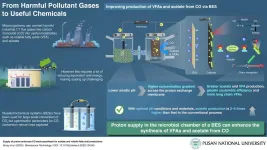
ELSE PRESS RELEASES FROM THIS DATE:
2021-02-17
BOSTON - Delirium, a common syndrome among older adults, particularly in those who have recently undergone surgery, critically ill patients in the ICU, and in older patients with multiple health issues, is a form of acute confusion that is characterized by poor attention, disorientation, impaired memory, delusions, and abrupt changes in mood and behavior. Moreover, patients who experience delirium are at increased risk of long term cognitive decline. Recently, clinicians and scientists have recognized that delirium is one of the first signs of COVID-19 infection in older patients and that it occurs frequently in patients with severe COVID-19 disease.
In a new study led by an interdisciplinary team of gerontologists, geriatricians, precision medicine ...
2021-02-17
Dogs are generally considered the first domesticated animal, while its ancestor is generally considered to be the wolf, but where the Australian dingo fits into this framework is still debated, according to a retired Penn State anthropologist.
"Indigenous Australians understood that there was something different about the dingoes and the colonial dogs," said Pat Shipman, retired adjunct professor of anthropology, Penn State. "They really are, I think, different animals. They react differently to humans. A lot of genetic and behavioral work has been done with wolves, dogs and dingoes. Dingoes come out somewhere ...
2021-02-17
Scientists from the Skoltech Center for Computational and Data-Intensive Science and Engineering (CDISE) and the Skoltech Digital Agriculture Laboratory and their collaborators from the German Aerospace Center (DLR) have developed an artificial intelligence (AI) system that enables processing images from autonomous greenhouses, monitoring plant growth and automating the cultivation process. Their research was published in the journal IEEE Sensors.
Modern technology has long become a fixture in all spheres of human life on Earth. Reaching out to other planets is a new challenge for humankind. Since greenhouses are likely to be the only source ...
2021-02-17
BOSTON - Use of a cosmetic laser invented at Massachusetts General Hospital (MGH) may improve the effectiveness of certain anti-tumor therapies and extend their use to more diverse forms of cancer. The strategy was tested and validated in mice, as described in a study published in Science Translational Medicine.
Immune checkpoint inhibitors are important medications that boost the immune system's response against various cancers, but only certain patients seem to benefit from the drugs. The cancer cells of these patients often have multiple mutations that can be recognized as foreign by the immune system, thereby inducing an inflammatory response.
In an attempt to expand the benefits of immune checkpoint inhibitors ...
2021-02-17
Leesburg, VA, February 17, 2021--According to an open-access article in ARRS' American Journal of Roentgenology (AJR), COVID-19-related disseminated leukoencephalopathy (CRDL) represents an important--albeit uncommon--differential consideration in patients with neurologic manifestations of coronavirus disease (COVID-19).
"Increasingly," wrote Colbey W. Freeman and colleagues from the University of Pennsylvania, "effects of COVID-19 on the brain are being reported, including acute necrotizing encephalopathy, infarcts, microhemorrhage, acute disseminated encephalomyelitis, and leukoencephalopathy."
Among the 2,820 patients with COVID-19 admitted to the authors' institution between ...
2021-02-17
When materials reach extremely small size scales, strange things begin to happen. One of those phenomena is the formation of mesocrystals.
Despite being composed of separate individual crystals, mesocrystals come together to form a larger, fused structure that behaves as a pure, single crystal. However, these processes happen at scales far too small for the human eye to see and their creation is extremely challenging to observe.
Because of these challenges, scientists had not been able to confirm exactly how mesocrystals form.
Now new research by a Pacific ...
2021-02-17
A considerable portion of the efforts to realize a sustainable world has gone into developing hydrogen fuel cells so that a hydrogen economy can be achieved. Fuel cells have distinctive advantages: high energy-conversion efficiencies (up to 70%) and a clean by-product, water. In the past decade, anion exchange membrane fuel cells (AEMFC), which convert chemical energy to electrical energy via the transport of negatively charged ions (anions) through a membrane, have received attention due to their low-cost and relative environment friendliness compared ...
2021-02-17
CHAMPAIGN, Ill. -- Researchers who focus on fat know that some adipose tissue is more prone to inflammation-related comorbidities than others, but the reasons why are not well understood. Thanks to a new analytical technique, scientists are getting a clearer view of the microenvironments found within adipose tissue associated with obesity. This advance may illuminate why some adipose tissues are more prone to inflammation - leading to diseases like type 2 diabetes, cancer and cardiovascular disorders - and help direct future drug therapies to treat obesity.
In a new study, University of Illinois ...
2021-02-17
A short-lived resurgence in the emission of ozone depleting pollutants in eastern China will not significantly delay the recovery of Earth's protective "sunscreen" layer, according to new research published Feb. 10 in Nature.
Stratospheric ozone, also known as Earth's ozone layer, helps shield us from the Sun's harmful Ultraviolet (UV) rays. Compounds like CFC-11 (Trichlorofluoromethane, also known as Freon-11), a chemical once considered safe and widely used as a refrigerant and in the production of insulation for buildings, rise to the stratosphere after emission on Earth's surface. Once in the atmosphere, CFC's are broken down by the UV light and result in the destruction of ozone molecules, both reducing stratospheric ozone concentrations globally ...
2021-02-17
A neural network system that analyzes photographs can rank and distinguish suspicious, potentially precancerous skin lesions, which can turn into the deadly skin malignancy melanoma if not caught and removed early. The system accurately scoped out suspicious lesions from 68 patients in a manner that mostly matched tried-and-true evaluations from dermatologists. The results suggest the platform could help clinicians spot suspicious lesions during clinical visits faster and on a larger scale, potentially allowing for earlier diagnosis and treatment. Melanoma is ...
LAST 30 PRESS RELEASES:
[Press-News.org] Skies of blue: Recycling carbon emissions to useful chemicals and reducing global warming
Researchers optimize a novel process for the efficient conversion of carbon emissions into useful chemicals like acetate using microbes


